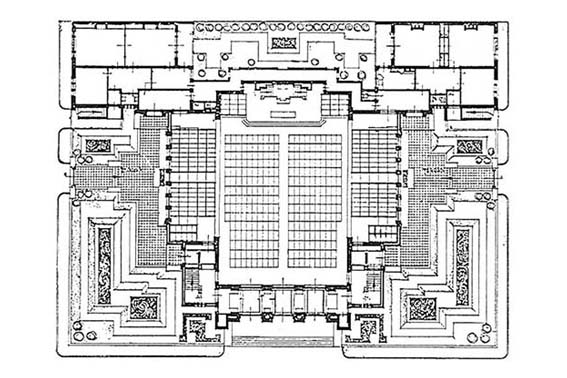Space forming a community, community forming a space
Architectural evaluation of idealized form for Protestant Churches in Europe after 1918
DOI:
https://doi.org/10.17979/aarc.2017.5.0.5141Keywords:
Europe, Modern Church Architecture, Protestant Theological Fundaments, Church Typology, CommunityAbstract
The identity is expressed in a self-picture, which has visible and immaterial marks. The church architecture is the essential appearance form of this, because it represents not the individual but the community. It gives an account of the self-identity conscience of the church through the community. In this way, architecture gets a great task: physically visualising this immaterial identity. This picture is formed with respect to the technical and aesthetic knowledge.
Does the basically recognizable protestant form exist? Are there ground-plans or spatial form elements, which are the obligate characteristics of these churches? Reflected well on the theological questions, we seek to detect what can determine the identity of the protestant churches in an aesthetic sense by a research highlighting the most important decesions on theological background and churches built in a term of a century.
Downloads
Metrics
References
Baku, Eszter. 2013. «Tradition and Liturgy. Centralising Tendencies of Lutheran Church Architecture in Hungary during the Interwar Period». Periodica Polytechnica Architecture 44/1:1-8.
Bartning, Otto. 1919. Vom Neuen Kirchenbau. Berlin: Verlag Bruno Cassirer.
Bartning, Otto, Otto Dorzbach and Anton Wechssler. 1949. Die 48 Notkirchen. Heidelberg: L. Schneider.
Biedrzynski, Richard. 1938. Kirchen Unserer Zeit. München: Hirmer Verlag.
Christ-Janer, Albert and Mary Mix Foley. 1962. Modern church architecture. A guide to the form and spirit of 20th century religious buildings. New York/Toronto/London: McGraw-Hill.
Daelemans, Bert. 2015. Spiritus Loci. A Theological method for Contemporary church architecture. Leiden-Boston: Brill.
Distel, Walter. 1933. Protestantischer Kirchenbau seit 1900 in Deutschland. Zürich: Orell Füssli Verlag.
Eliade, Mircea. 1959. The Sacred and the Profane. The Nature of Religion. New York: Harcourt, Brace & World.
Fernández-Cobián, Esteban, ed. 2009. Arquitecturas de lo sagrado. Memoria y proyecto. Oleiros: Netbiblo.
Fiamová, Martina, and Pavol Jakubèin, eds. 2010. Prenasledovanie cirkví v komunistických štátoch strednej a východnej Európy. Bratislava: Ústav Pamäti Národa.
Freckmann, Karl. 1931. Kirchenbau. Ratschläge und Beispiele. Freiburg: Herder.
Genz, Peter. 2011. Das Wiesbadener Programm. Johannes Otzen und die Geschichte eines Kirchenbautyps zwischen 1891 und 1930. Kiel: Steve-Holger Ludwig.
Harasimowicz, Jan, ed. 2015. Protestantischer Kirchenbau der Frühen Neuzeit in Europa: Grundlagen und neue Forschungskonzepte. Regensburg: Schnell und Steiner.
James-Chakraborty, Kathleen. 2000. German Architecture for a Mass Audience. London/New York: Routledge.
Kidder Smith, G.E. 1964. The New Churches of Europe. Las Nuevas Iglesias de Europa. London: Architectural Press.
Körner, Hans and Jürgen Wiener, eds. 2010. Liturgie als Bauherr? Moderne Sakralarchitectur und ihre Ausstattung Zwischen Funktion und Form. Essen: Klartext.
Krähling, János and Gergely Domonkos Nagy. 2011. «Príspevok k výskumu architektoktonického dedièstva slovenských evanjelikov v Uhorsku - tradícia Barokovej centrality». Architektúra & Urbanizmus 45/1-2:2-19.
Krähling, János. 2008. «A 20. századi magyarországi evangélikus templomépítészet a rendszerváltozásig». In Új evangélikus templomok, edited by János Krähling and Zorán Vukoszávlyev, 21-28. Budapest: Luther Kiadó.
Krähling, János. 2015. «The protestant church architecture of East-Central Europe in the seventeenth and eightteenth centuries: From medieval heritage to new spatial solutions». In Protestantischer Kirchenbau der Frühen Neuzeit in Europa – Grundlagen und neue Forschungskonzepte, edited by Jan Harasimowicz, 131-146. Regensburg: Schnell und Steiner.
Kurrent, Friedrich. 2008. «Die Evang.-Luth. Waldkirche in Planegg». In Die Münchner Kirchen. Architektur, Kunst, Liturgie, edited by Andreas Hildmann and Norbert Jocher, 283-287. Regensburg: Schnell & Steiner.
March, Otto. 1896. Unsere Kirchen und gruppierter Bau bei Kirchen. Berlin: Ernst.
Mayer, Hans K.F. 1951. Der Baumeister Otto Bartning und die Wiederentdeckung des Raumes. Heidelberg: Verlag Lambert Schneider.
Mentzer Jr., Raymond A. 1999. «The Reformed Churches of France and the Visual Arts». In Seeing Beyond the Word: Visual Arts and the Calvinist Tradition, edited by Paul Corby Finney, 199-230. Cambridge: William B. Eerdmans Publishing.
Moravánszky, Ákos. 1998. Competing Visions: Aesthetic Invention and Social Imagination in Central European Architecture, 1867-1918. Cambridge/London: MIT Press.
Neuzeitlicher Kirshenbau: Die Verhandlungen des III. Kongresses für evangelischen Kirchenbau, Magdeburg, den 2. bis 4. Mai 1928. Halle: Buchhandlung des Waisenhauses.
Otzen, Johannes. 1891. «Central arrangement plans». De Opmerker 37 (September 12).
Pallister, James. 2015. Sacred Spaces: Contemporary Religious Architecture. New York/London: Phaidon.
Seasoltz, Kevin R. 2005. A Sense of the Sacred. Theological Foundations of Christian Architecture and Art. New York-London: Continuum.
Schnell, Hugo. 1973. Der Kirchenbau des 20. Jahrhunderts in Deutchland. Dokumentation, Darstellung, Deutung. München-Zürich: Verlag Schnell & Steiner. (English edition in 1974. Twentieth Century Church Architecture in Germany. Documentation, Presentation, Interpretation).
Spicer, Andrew. 2007. Calvinist Churches in Early Modern Europe. Manchester: Manchester University Press.
Spicer, Andrew, ed. 2012. Lutheran Chruches in Early Modern Europe. Farnham-Burlington: Ashgate.
Spicer, Andrew. 2016. Parish Churches in the Early Modern World. Farnham-Burlington: Ashgate.
Stock, Wolfgang Jean. 2004. Architectural Guide. Christian Sacred Building in Europe since 1950. München/Berlin/London/New York: Prestel.
Sturm, Leonard Christoph. 1712. Architektonisches Bedencken von Protestantischer Kleinen Kirchen Figur und Einrichtung. Hamburg.
Sturm, Leonard Christoph. 1718. Vollständige Anweisung alle Arten von Kirchenwohl anzugeben. Augsburg.
Sulze, Emil. 1891. Die evangelische Gemeinde. Gotha: FA Perthes.
Tillich, Paul. 1962. «Contemporary Protestant Architecture». In Modern church architecture. A guide to the form and spirit of 20th century religious buildings, edited by Albert Christ-Janer and Mary Mix Foley, 122-125. New York/Toronto/London: McGraw-Hill.
Veesenmeyer, Emil. 1895. «Der Kirchenbau des Protestantismus und das sogenannte Wiesbadener Programm». Evangelisches Gemeindeblatt, Heft Nummer 15.
Vukoszávlyev, Zorán. 2014. «Church At The Border. Church Architecture in Hungary from the start of 20th Century». In Arte Architettura Liturgia Esperienze Internazionali a Confronto 6: Atti dell’8° Convegno Internazionale Venezia 21 e 22 ottobre 2010, edited by Giorgio Della Longa, Antonio Marchesi and Walter Zahner, 17-41. Lavis: Alcion Edizioni.
Vukoszávlyev, Zorán. 2012. «Unifying the Community. The Evolution of Centralized Space in Hungarian Church Architecture 1900-2010». In Proceedings of the 2nd International Conference of the European Architectural History Network, edited by Hilde Heynen and Janina Gosseye, 364-365. Brussel: Koninklijke Vlaamse Academie van Belgie voor Wetenschappen en Kunsten.
Vukoszávlyev, Zorán and Erzsébet Urbán. 2016. «Magyarország templomépítészete 1945–1964 között. Vázlat az alkotómûvészi értékeléssel megállapítható építészeti folytonosságról». Építés-Építészettudomány 44/1-2:247-315.
Wattjes, J.G. 1931. Moderne Kerken in Europa en Amerika. Amsterdam: Uitgevers/Maatschappij Kosmos.
Weyres, Willy and Otto Bartning. 1959. Kirchen. Handbuch für den Kirchenbau. München: Verlag Georg D.W.Callwey.
















